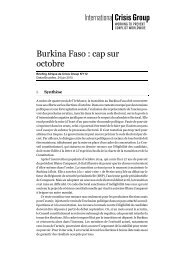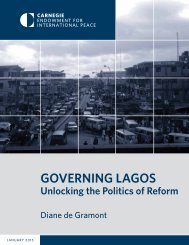Violence in Nigeria
ASC-075287668-3743-01
ASC-075287668-3743-01
Create successful ePaper yourself
Turn your PDF publications into a flip-book with our unique Google optimized e-Paper software.
8<br />
records of lethal violence <strong>in</strong> some of the 774 Local Government Areas (LGAs) of<br />
the <strong>Nigeria</strong>n Federation, either because these LGAs are very peaceful or, more<br />
probably, because they are not covered by the media. 19<br />
Hence, the second part of this book <strong>in</strong>vestigates ‘<strong>in</strong>visible’ violence through<br />
four case studies, two each for the South and the North. In the relevant LGAs, all<br />
rural, surveys were conducted to document violence-related deaths dur<strong>in</strong>g the<br />
same time frame as the period covered by the previous chapters based on the statistics<br />
of the <strong>Nigeria</strong> Watch dataset from 1 June 2006 to 31 May 2014. Their<br />
f<strong>in</strong>d<strong>in</strong>gs complement the quantitative studies of the first part of this book.<br />
In Chapter 7, Joach<strong>in</strong> Uche Okanume Survey beg<strong>in</strong>s with a survey of violence-related<br />
deaths <strong>in</strong> An<strong>in</strong>ri and Isi-Uzo LGAs of Enugu State. These areas are<br />
predom<strong>in</strong>antly <strong>in</strong>habited by farmers and traders; however, their pattern of violence<br />
is not very different from the other regions of <strong>Nigeria</strong> if we make an exception<br />
for the North-East and the Boko Haram crisis. In An<strong>in</strong>ri, for <strong>in</strong>stance, the<br />
majority of fatal <strong>in</strong>cidents result from motor accidents, while crime is the second<br />
lead<strong>in</strong>g cause of fatalities. In the case of Isi-Uzo, crime is the lead<strong>in</strong>g cause of<br />
fatalities. Lack of development partly expla<strong>in</strong>s these differences locally, as Isi-<br />
Uzo has almost no roads. This lack of development also provides a clue to the<br />
reluctance of the national press to report news <strong>in</strong> rural LGAs that have no economic<br />
value, lack urban centres, and are difficult to access, such as Isi-Uzo.<br />
In Chapter 8, Hammed Abodunr<strong>in</strong> studies Egbedore and Ifedayo LGAs of<br />
Osun State. Residents, he f<strong>in</strong>ds, do not consider these areas to be violent; however,<br />
some fatal <strong>in</strong>cidents were reported over land disputes, police clashes, and personal<br />
attacks. Like most regions of <strong>Nigeria</strong>, motor accidents accounted for the<br />
majority of violent deaths <strong>in</strong> Egbedore and Ifedayo, ma<strong>in</strong>ly because of bad roads,<br />
accord<strong>in</strong>g to respondents. Interviews conducted with journalists <strong>in</strong> Osun also revealed<br />
a number of reasons for the media not adequately cover<strong>in</strong>g such rural areas.<br />
There were claims of bad roads, poor transportation services, and irregular<br />
salaries, which h<strong>in</strong>dered the ability of journalists to visit remote parts of the state.<br />
In addition, journalists po<strong>in</strong>ted to the lack of community newspapers and the different<br />
media house styles, which saw some stories as not weighty enough to<br />
make national news. F<strong>in</strong>ally, they stressed the uncooperative attitude of security<br />
operatives <strong>in</strong> regard to releas<strong>in</strong>g <strong>in</strong>formation.<br />
In Chapter 9, Adam Alqali takes us to the north of <strong>Nigeria</strong> to <strong>in</strong>vestigate lethal<br />
violence <strong>in</strong> Baure, Ingawa, Kurfi, Mani, and Matazu LGAs of Kats<strong>in</strong>a State. His<br />
research reveals 37 fatal <strong>in</strong>cidents <strong>in</strong> unreported cases of violence, which resulted<br />
19<br />
By 1 November 2014, these were the follow<strong>in</strong>g: Udung Uko and Urue-Offong/Oruko (Akwa Ibom);<br />
Kwaya Kusar (Borno); Nafada (Gombe); Auyo, Gagarawa, Kaugama, and Yankwashi (Jigawa);<br />
Ingawa and Matazu (Kats<strong>in</strong>a); Sakaba (Kebbi); Bassa, Igalamela-Odolu, and Mopa-Muro (Kogi); Toto<br />
(Nassarawa); Ifedayo (Osun); Gudu and Gwadabaw (Sokoto); Ussa (Taraba); and Karasuwa,<br />
Mach<strong>in</strong>a, Nguru, and Yunusari (Yobe).






